The Value Expression and Driving Factors of Rural Spatial Ecological Products: A Case Study of B&Bs in Jiangsu and Zhejiang Provinces, China
Abstract
1. Introduction
2. Conception and Classification
2.1. The Concept and Property of Rural Spatial Ecological Products
2.2. The Essence and Characteristics of Rural Spatial Ecological Products
2.3. Development Types of Rural Spatial Ecological Products
2.3.1. Industrial Space
2.3.2. Consumption Space
2.3.3. Living Space
3. Materials and Methods
3.1. Study Area
3.2. Data Sources and Processing
3.3. Methods
3.3.1. Comparative Analysis Method
3.3.2. Kriging Space Interpolation Method
4. Results
4.1. Value Performance
4.2. Driving Factors
5. Discussion
5.1. Research Findings Compared with Other Studies
5.2. Research Limitations
5.3. Practical Implications
6. Conclusions
Author Contributions
Funding
Data Availability Statement
Conflicts of Interest
References
- Ohe, Y.; Ikei, H.; Song, C.; Miyazaki, Y. Evaluating the relaxation effects of emerging forest-therapy tourism: A multidisciplinary approach. Tour. Manag. 2017, 62, 322–334. [Google Scholar] [CrossRef]
- Jing, Y.; Liu, Y.; Cai, E.; Zhang, Y. Quantifying the spatiality of urban leisure venues in Wuhan, Central China–GIS-based spatial pattern metrics. Sustain. Cities Soc. 2018, 40, 638–647. [Google Scholar] [CrossRef]
- Xiao, Y.; Tang, X.; Wang, J.; Huang, H.; Liu, L. Assessment of coordinated development between tourism development and resource environment carrying capacity: A case study of Yangtze River economic Belt in China. Ecol. Indic. 2022, 141, 109125. [Google Scholar] [CrossRef]
- Shi, Z.; Xu, D.; Xu, L. Spatiotemporal characteristics and impact mechanism of high-quality development of cultural tourism in the Yangtze River Delta urban agglomeration. PLoS ONE 2021, 16, e0252842. [Google Scholar] [CrossRef] [PubMed]
- Zuo, Y.; Zhang, L. Research on Local Ecosystem Cultural Services in the Jiangnan Water Network Rural Areas: A Case Study of the Ecological Green Integration Demonstration Zone in the Yangtze River Delta, China. Land 2023, 12, 1373. [Google Scholar] [CrossRef]
- Gao, C.; Cheng, L. Tourism-driven rural spatial restructuring in the metropolitan fringe: An empirical observation. Land Use Policy 2020, 95, 104609. [Google Scholar] [CrossRef]
- Zhang, Q.; Lu, L.; Huang, J.; Zhang, X. Uneven development and tourism gentrification in the metropolitan fringe: A case study of Wuzhen Xizha in Zhejiang Province, China. Cities 2021, 121, 103476. [Google Scholar] [CrossRef]
- Wang, J.; Zhang, Y. Analysis on the evolution of rural settlement pattern and its influencing factors in China from 1995 to 2015. Land 2021, 10, 1137. [Google Scholar] [CrossRef]
- Zhang, X.; Pan, M. Emerging rural spatial restructuring regimes in China: A tale of three transitional villages in the urban fringe. J. Rural. Stud. 2020, 93, 287–300. [Google Scholar] [CrossRef]
- Li, H.; Yuan, Y.; Zhang, X.; Li, Z.; Wang, Y.; Hu, X. Evolution and transformation mechanism of the spatial structure of rural settlements from the perspective of long-term economic and social change: A case study of the Sunan region, China. J. Rural. Stud. 2019, 93, 234–243. [Google Scholar] [CrossRef]
- Tu, S.; Long, H.; Zhang, Y.; Ge, D.; Qu, Y. Rural restructuring at village level under rapid urbanization in metropolitan suburbs of China and its implications for innovations in land use policy. Habitat Int. 2018, 77, 143–152. [Google Scholar] [CrossRef]
- Cuadrado-Ciuraneta, S.; Durà-Guimerà, A.; Salvati, L. Not only tourism: Unravelling suburbanization, second-home expansion and “rural” sprawl in Catalonia, Spain. Urban Geogr. 2017, 38, 66–89. [Google Scholar] [CrossRef]
- Wei, C.; Zheng, G. Measuring and Evaluating the Commodification of Sustainable Rural Living Areas in Zhejiang, China. Sustainability 2023, 15, 3349. [Google Scholar] [CrossRef]
- Bell, D.; Jayne, M. The creative countryside: Policy and practice in the UK rural cultural economy. J. Rural. Stud. 2010, 26, 209–218. [Google Scholar] [CrossRef]
- Horáková, H.; Boscoboinik, A. From Production to Consumption: Transformation of Rural Communities; LIT Verlag: Münster, Germany, 2012. [Google Scholar]
- Stiman, M. Second homes in the city and the country: A reappraisal of vacation homes in the twenty-first century. Int. J. Hous. Policy 2019, 20, 53–74. [Google Scholar] [CrossRef]
- Long, H.; Ma, L.; Zhang, Y.; Qu, L. Multifunctional rural development in China: Pattern, process and mechanism. Habitat Int. 2022, 121, 102530. [Google Scholar] [CrossRef]
- Zhang, R.; Zhang, X. Spatial–Temporal differentiation and the driving mechanism of rural transformation development in the Yangtze river economic belt. Sustainability 2022, 14, 2584. [Google Scholar] [CrossRef]
- Wu, T. Agriculture tourism and the transformation of rural countryside. Tour. Geogr. 2018, 20, 354–357. [Google Scholar] [CrossRef]
- Cui, J.; Li, R.; Zhang, L.; Jing, Y. Spatially Illustrating Leisure Agriculture: Empirical Evidence from Picking Orchards in China. Land 2021, 10, 631. [Google Scholar] [CrossRef]
- Yang, J.; Ma, H.; Weng, L. Transformation of Rural Space under the Impact of Tourism: The Case of Xiamen, China. Land 2022, 11, 928. [Google Scholar] [CrossRef]
- Wang, W.; Yang, Q.; Gan, X.; Zhao, X.; Zhang, J.; Yang, H. Spatial Distribution Pattern and Influencing Factors of Homestays in Chongqing, China. Appl. Sci. 2022, 12, 8832. [Google Scholar] [CrossRef]
- Bi, G.; Yang, Q. The spatial production of rural settlements as rural homestays in the context of rural revitalization: Evidence from a rural tourism experiment in a Chinese village. Land Use Policy 2023, 128, 106600. [Google Scholar] [CrossRef]
- Ye, X.Q. China’s rural areas toward 2035: Vision, challenges and strategies. J. Manag. World 2021, 4, 98–111. (In Chinese) [Google Scholar] [CrossRef]
- Daliy, G.C. Nature’s Services: Societal Depgradeence on Natural Ecosystems; Island Press: Washington, DC, USA, 1997. [Google Scholar]
- Costanza, R.; d’Arge, R.; de Groot, R.; Farber, S.; Grasso, M.; Hannon, B.; Limburg, K.; Naeem, S.; O’Neill, R.V.; Paruelo, J.; et al. The value of the world’s ecosystem services and natural capital. Nature 1997, 387, 253–260. [Google Scholar] [CrossRef]
- Wang, J.N.; Wang, Z.K.; Liu, G.H.; Ma, G.X.; Wang, X.H.; Zhao, Y.H.; Yang, W. A framework research of theory and its practice of the fourth industry of ecological products. Chin. J. Environ. Manag. 2021, 13, 5–13. (In Chinese) [Google Scholar]
- De Groot, R.S.; Wilson, M.A.; Boumans, R.M.J. A typology for the classification, description and valuation of ecosystem functions, goods and services. Ecol. Econ. 2002, 41, 393–408. [Google Scholar] [CrossRef]
- Ma, G.; Wang, J.; Yu, F.; Yang, W.; Ning, J.; Peng, F.; Zhou, X.; Zhou, Y.; Cao, D. Framework construction and application of China’s Gross Economic-Ecological Product accounting. J. Environ. Manag. 2020, 264, 109852. [Google Scholar] [CrossRef]
- Constant, N.L.; Taylor, P.J. Restoring the forest revives our culture: Ecosystem services and values for ecological restoration across the rural-urban nexus in South Africa. For. Policy Econ. 2020, 118, 102222. [Google Scholar] [CrossRef]
- Yuan, Y.; Yang, Y.; Wang, R.; Cheng, Y. Predicting Rural Ecological Space Boundaries in the Urban Fringe Area Based on Bayesian Network: A Case Study in Nanjing, China. Land 2022, 11, 1886. [Google Scholar] [CrossRef]
- Jiang, G.; Wang, M.; Qu, Y.; Zhou, D.; Ma, W. Towards cultivated land multifunction assessment in China: Applying the “influencing factors-functions-products-demands” integrated framework. Land Use Policy 2020, 99, 104982. [Google Scholar] [CrossRef]
- Li, Y.; Fan, Z.; Jiang, G.; Quan, Z. Addressing the Differences in Farmers’ Willingness and Behavior Regarding Developing Green Agriculture—A Case Study in Xichuan County, China. Land 2021, 10, 316. [Google Scholar] [CrossRef]
- Chen, P.; Kong, X. Tourism-led Commodification of Place and Rural Transformation Development: A Case Study of Xixinan Village, Huangshan, China. Land 2021, 10, 694. [Google Scholar] [CrossRef]
- Fløysand, A.; Jakobsen, S.-E. Commodification of rural places: A narrative of social fields, rural development, and football. J. Rural. Stud. 2007, 23, 206–221. [Google Scholar] [CrossRef]
- Fu, L.; Sanada, J. Spatial Patterns and Influencing Factors of Rural Land Commodification at Township Scale: A Case Study in Shijiazhuang City, North China. Land 2023, 12, 1194. [Google Scholar] [CrossRef]
- Jiang, W.; Marggraf, R. Making Intangibles Tangible: Identifying Manifestations of Cultural Ecosystem Services in a Cultural Landscape. Land 2021, 11, 26. [Google Scholar] [CrossRef]
- Jinhe, Z.; Yang, S.; Linsheng, Z.; Chengzhao, W.; Yujun, Z.; Peng, L.; Huaju, X.; Feifei, X.; Hongmei, Z.; Xiangju, Z. Scientific protection of national parks and high-quality development of tourism: Theoretical thinking and innovative practice. ECOTOURISM 2022, 12, 189–207. (In Chinese) [Google Scholar] [CrossRef]
- Cheng, X.; Van Damme, S.; Uyttenhove, P. Assessing the Impact of Park Renovations on Cultural Ecosystem Services. Land 2022, 11, 610. [Google Scholar] [CrossRef]
- Zhao, N.; Wang, H.; Zhong, J.; Sun, D. Assessment of Recreational and Cultural Ecosystem Services Value of Islands. Land 2022, 11, 205. [Google Scholar] [CrossRef]
- Feng, Z.; Cui, Y.; Zhang, H.; Gao, Y. Assessment of human consumption of ecosystem services in China from 2000 to 2014 based on an ecosystem service footprint model. Ecol. Indic. 2018, 94, 468–481. [Google Scholar] [CrossRef]
- Kim, J.; Yoon, S.; Yang, E.; Thapa, B. Valuing recreational beaches: A spatial hedonic pricing approach. Coast. Manag. 2020, 48, 118–141. [Google Scholar] [CrossRef]
- Pan, H.; Yang, T.; Jin, Y.; Dall’erba, S.; Hewings, G. Understanding heterogeneous spatial production externalities as a missing link between land-use planning and urban economic futures. Reg. Stud. 2020, 55, 90–100. [Google Scholar] [CrossRef]
- Lefebvre, H. Critique of Everyday Life, Vol. 1: Introduction; Verso Books: Brooklyn, NY, USA, 2008. [Google Scholar]
- Gao, J.; Jiang, W.; Chen, J.; Liu, Y. Housing-industry symbiosis in rural China: A multi-scalar analysis through the lens of land use. Appl. Geogr. 2020, 124, 102281. [Google Scholar] [CrossRef]
- Lv, Z.; Yang, A.; Wang, Y. Characteristics, Drivers, and Development Modes of Rural Space Commercialization under Different Altitude Gradients: The Case of the Mountain City of Chongqing. Land 2023, 12, 1028. [Google Scholar] [CrossRef]
- Bai, X.; Shi, P.; Liu, Y. Society: Realizing China’s urban dream. Nature 2014, 509, 158–160. [Google Scholar] [CrossRef] [PubMed]
- Zhou, J.; Xiong, K.; Wang, Q.; Tang, J.; Lin, L. A Review of ecological assets and ecological products supply: Implications for the karst rocky desertification control. Int. J. Environ. Res. Public Health 2022, 19, 10168. [Google Scholar] [CrossRef] [PubMed]
- Guo, X.; Yu, B.; Yan, M.; Guo, H.; Ren, J.; Zhang, H.; Zhang, Z. Endogenous Development Models and Paths Selection of Rural Revitalization from the Perspective of Ecological Environment Advantages: A Case Study of Nanshi Village, China. Int. J. Environ. Res. Public Health 2022, 19, 11979. [Google Scholar] [CrossRef] [PubMed]
- Deng, X.; Wang, G.; Song, W.; Chen, M.; Liu, Y.; Sun, Z.; Dong, J.; Yue, T.; Shi, W. An Analytical Framework on Utilizing Natural Resources and Promoting Urban–Rural Development for Increasing Farmers’ Income Through Industrial Development in Rural China. Front. Environ. Sci. 2022, 10, 865883. [Google Scholar] [CrossRef]
- Liu, S. A Retrospection, Introspection and Expectation of Art Practices Engaged Socially in the Rural Construction—Based on Qingtian Paradigm from Perspective of Anthropology. J. Ethn. Art. 2017, 4, 5–13. (In Chinese) [Google Scholar] [CrossRef]
- Wang, F.; Zhao, X.; Qiu, Y.; Dong, S.; Wang, S.; Xue, P. A study on native and constructed localities in the modern adaptation of villages. Habitat Int. 2023, 138, 102849. [Google Scholar] [CrossRef]
- Shen, M.; Shen, J. State-led commodification of rural China and the sustainable provision of public goods in question: A case study of Tangjiajia, Nanjing. J. Rural. Stud. 2019, 93, 449–460. [Google Scholar] [CrossRef]
- Lei, L.; Xigang, Z.; Jie, S. State-sponsored Rural Gentrification and Its Mechanism: A Case Study of Bulao Village, Nanjing. Shanghai Urban Plan. Rev. 2019, 2, 131–136. (In Chinese) [Google Scholar]
- Liu, Y.; Nie, L.; Wang, F.; Nies, Z. The impact of tourism development on local residents in Bama, Guangxi, China. Tour. Econ. 2015, 21, 1133–1148. [Google Scholar] [CrossRef]
- Bundale, A.H. The Implications of Mainstreaming Sustainable Development: A Study of Civilized Ecological Villages in Hainan, China; Library and Archives Canada = Bibliothèque et Archives: Ottawa, ON, Canada, 2006. (In Chinese) [Google Scholar]
- Kuntz, M.; Helbich, M. Geostatistical mapping of real estate prices: An empirical comparison of kriging and cokriging. Int. J. Geogr. Inf. Sci. 2014, 28, 1904–1921. [Google Scholar] [CrossRef]
- Yin, S.G.; Song, W.X.; Ma, Z.F.; Li, Z.J.; Wu, Q.Y. Spatial differentiation and influencing factors analysis of housing prices in Nanjing: Based on geographically weighted regression model. Hum. Geogr. 2018, 33, 68–77. (In Chinese) [Google Scholar]
- Ma, D.; Sun, D.; Wng, Z. Exploring the Rural Revitalization Effect under the Interaction of Agro-Tourism Integration and Tourism-Driven Poverty Reduction: Empirical Evidence for China. Land 2024, 13, 60. [Google Scholar] [CrossRef]
- Jiang, S.; Ma, H.; Yang, L.; Luo, S. The Influence of Perceived Physical and Aesthetic Quality of Rural Settlements on Tourists’ Preferences—A Case Study of Zhaoxing Dong Village. Land 2023, 12, 1542. [Google Scholar] [CrossRef]
- Mokarram, M.; Sathyamoorthy, D. A review of landform classification methods. Spat. Inf. Res. 2018, 26, 647–660. [Google Scholar] [CrossRef]
- Qiao, H.-H.; Wang, C.-H.; Chen, M.-H.; Su, C.-H.; Tsai, C.-H.; Liu, J. Hedonic price analysis for high-end rural homestay room rates. J. Hosp. Tour. Manag. 2021, 49, 1–11. [Google Scholar] [CrossRef]
- Everard, M.; Kataria, G. Recreational angling markets to advance the conservation of a reach of the Western Ramganga River, India. Aquat. Conserv. Mar. Freshw. Ecosyst. 2010, 21, 101–108. [Google Scholar] [CrossRef]
- Bohensky, E.; Reyers, B.; Van Jaarsveld, A.; Fabricius, C. Ecosystem Services in the Gariep Basin–A Basin-Scale Component of the Southern African Millenium Ecosystem Assessment; Sun Media Bloemfontein Pty Ltd.: Bloemfontein, South Africa, 2004; ISBN 9781919980386. [Google Scholar]
- Niemelä, J.; Saarela, S.-R.; Söderman, T.; Kopperoinen, L.; Yli-Pelkonen, V.; Väre, S.; Kotze, D.J. Using the ecosystem services approach for better planning and conservation of urban green spaces: A Finland case study. Biodivers. Conserv. 2010, 19, 3225–3243. [Google Scholar] [CrossRef]
- Edwards, D.M.; Jay, M.; Jensen, F.S.; Lucas, B.; Marzano, M.; Montagné, C.; Peace, A.; Weiss, G. Public preferences across Europe for different forest stand types as sites for recreation. Ecol. Soc. 2012, 17, 27. [Google Scholar] [CrossRef]
- Cooley, S.R.; Kite-Powell, H.L.; Doney, S.C. Ocean acidification’s potential to alter global marine ecosystem services. Oceanography 2009, 22, 172–181. [Google Scholar] [CrossRef]
- van Berkel, D.B.; Verburg, P.H. Spatial quantification and valuation of cultural ecosystem services in an agricultural landscape. Ecol. Indic. 2014, 37, 163–174. [Google Scholar] [CrossRef]
- Yuan, L.-L.; Wang, S.-J. Recreational value of glacier tourism resources: A travel cost analysis for Yulong Snow Mountain. J. Mt. Sci. 2018, 15, 1446–1459. [Google Scholar] [CrossRef]
- Zhao, Y.; You, W.; Lin, X.; He, D. Assessing the supply and demand linkage of cultural ecosystem services in a typical county-level city with protected areas in China. Ecol. Indic. 2023, 147, 109992. [Google Scholar] [CrossRef]
- Kim, Y.; Kim, C.-K.; Lee, D.K.; Lee, H.-W.; Andrada, R.I.T. Quantifying nature-based tourism in protected areas in developing countries by using social big data. Tour. Manag. 2019, 72, 249–256. [Google Scholar] [CrossRef]
- Bachi, L.; Ribeiro, S.C.; Hermes, J.; Saadi, A. Cultural Ecosystem Services (CES) in landscapes with a tourist vocation: Mapping and modeling the physical landscape components that bring benefits to people in a mountain tourist destination in southeastern Brazil. Tour. Manag. 2019, 77, 104017. [Google Scholar] [CrossRef]
- Fleischer, A. A room with a view—A valuation of the Mediterranean Sea view. Tour. Manag. 2012, 33, 598–602. [Google Scholar] [CrossRef]
- Mendoza-González, G.; Martínez, M.L.; Guevara, R.; Pérez-Maqueo, O.; Garza-Lagler, M.C.; Howard, A. Towards a sustainable sun, sea, and sand tourism: The value of ocean view and proximity to the coast. Sustainability 2018, 10, 1012. [Google Scholar] [CrossRef]
- Zhang, Q.; Ye, C.; Duan, J. Multi-dimensional superposition: Rural collaborative governance in Liushe Village, Suzhou City. J. Rural. Stud. 2022, 96, 141–153. [Google Scholar] [CrossRef]

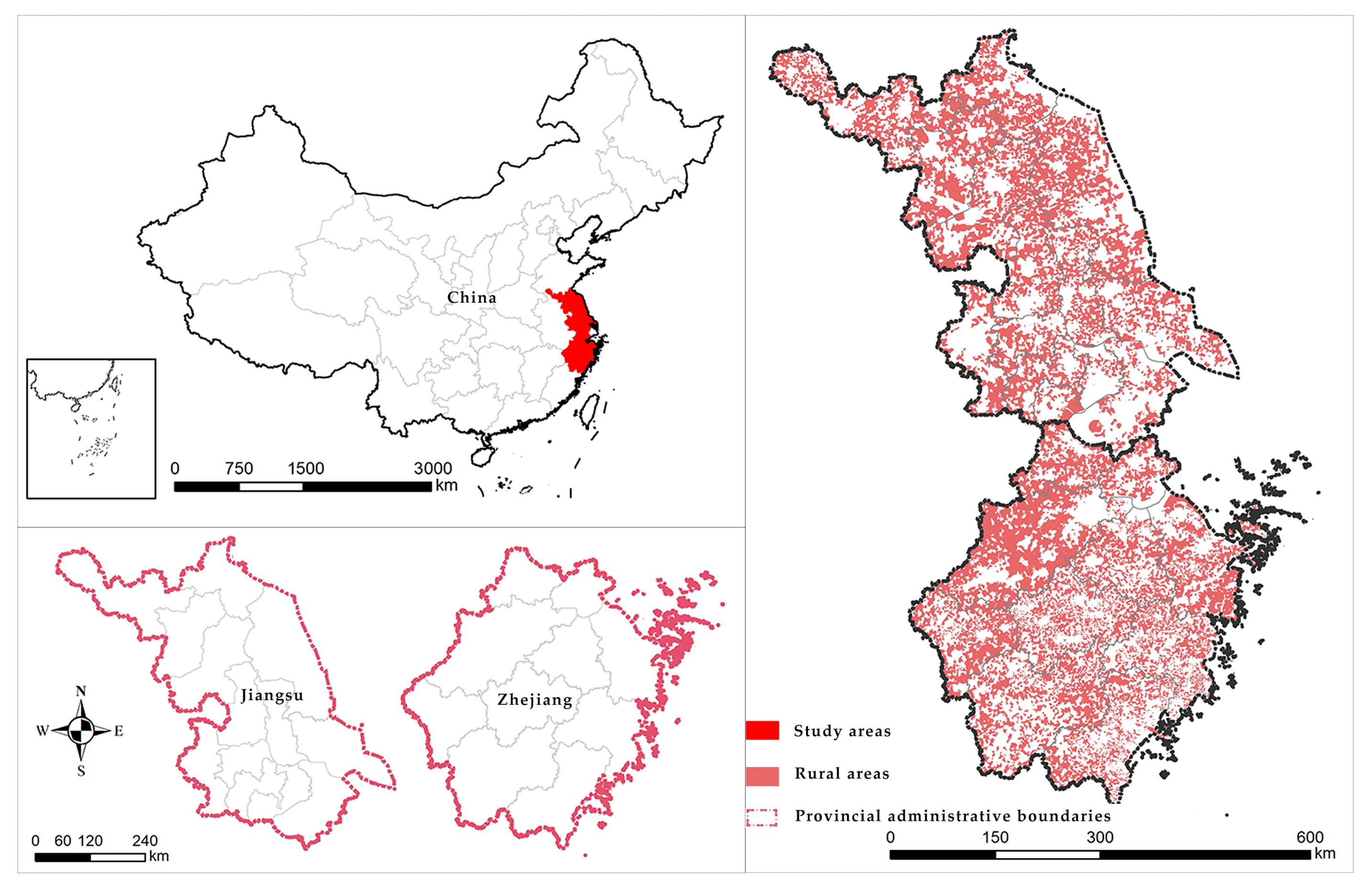
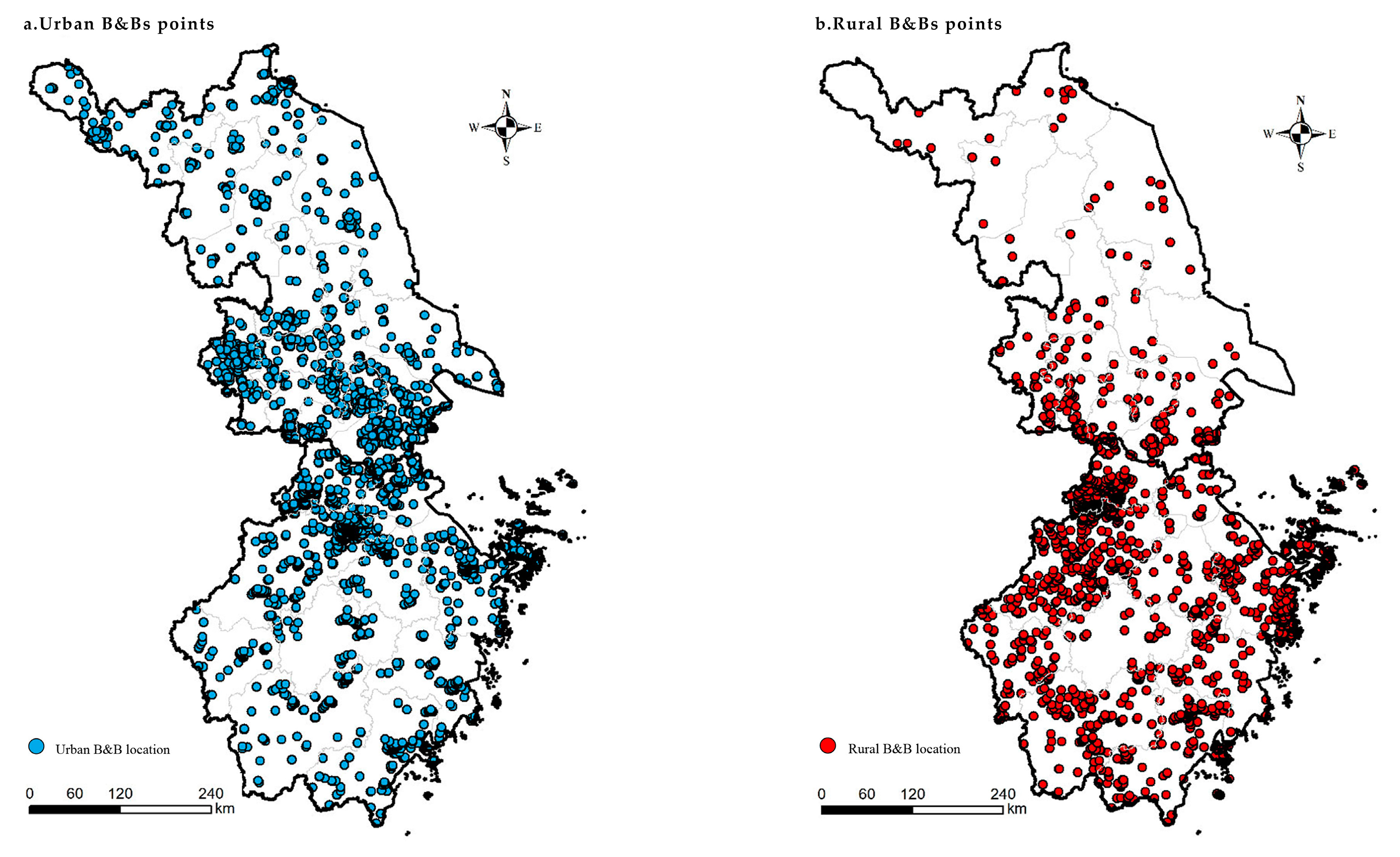
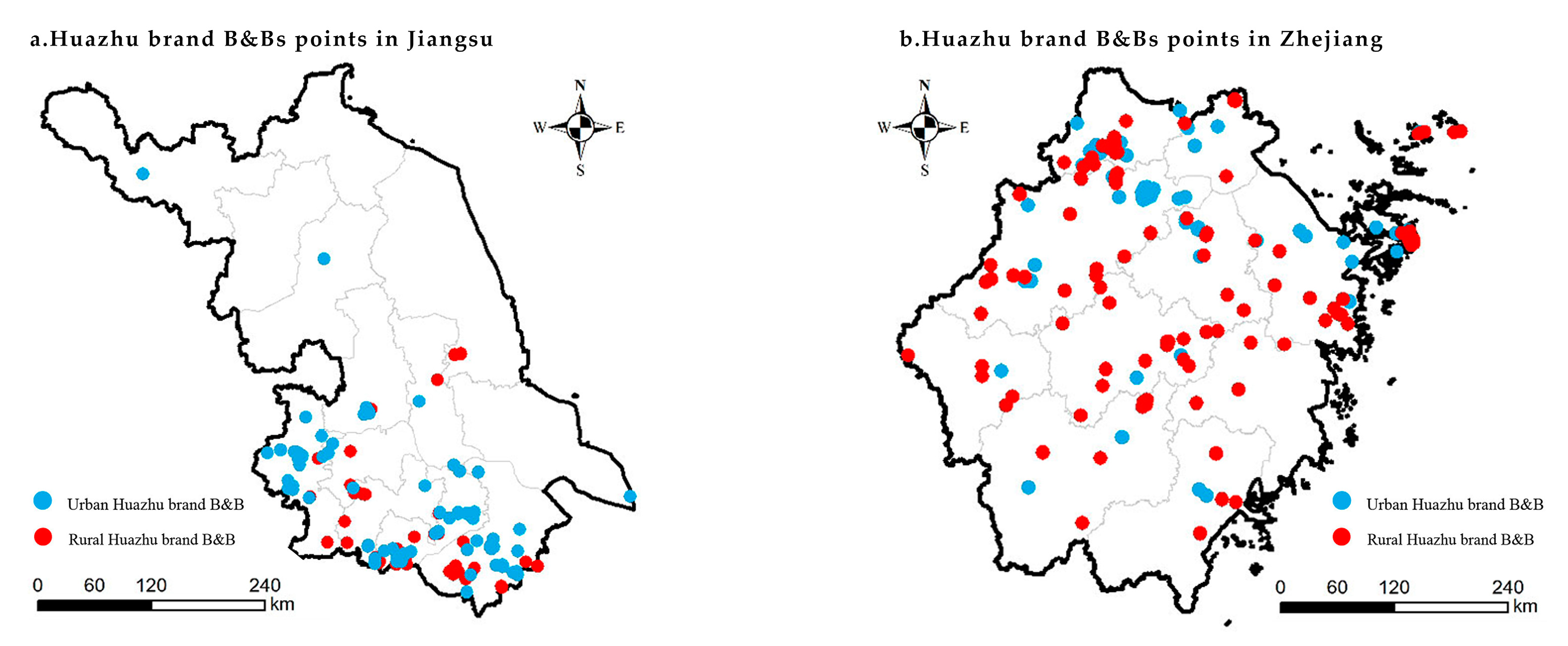
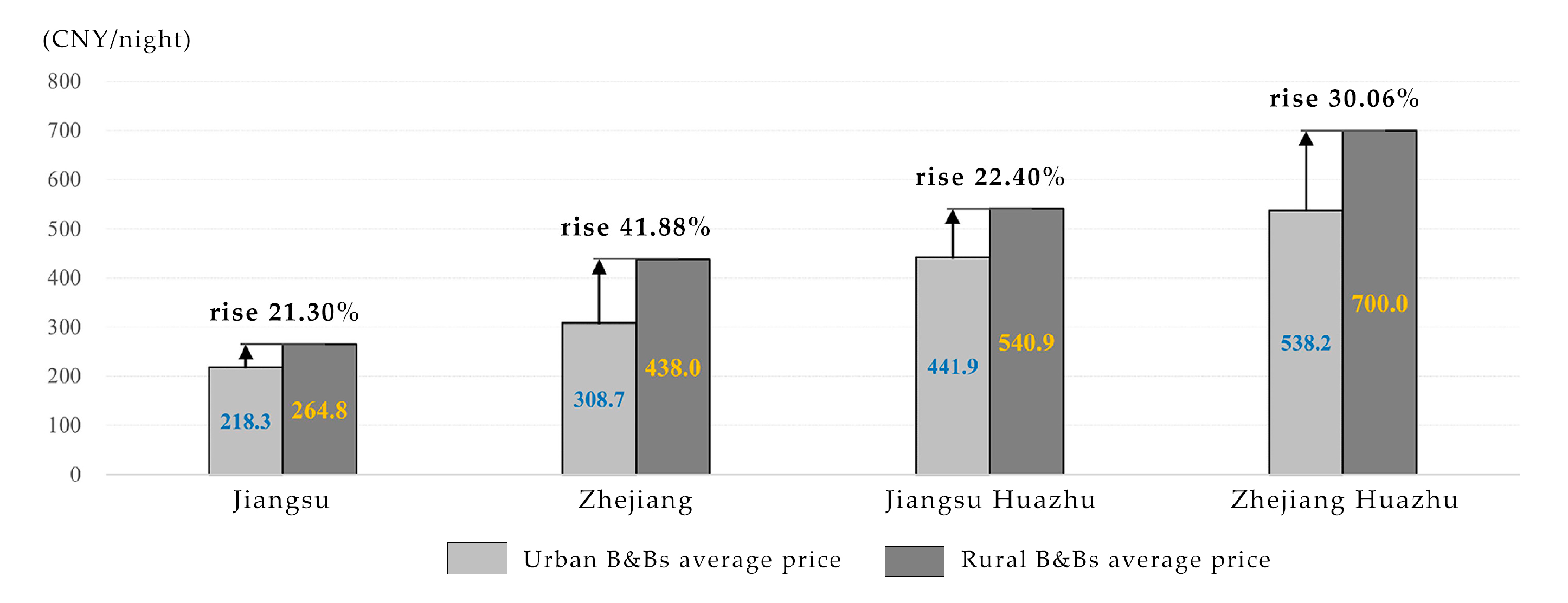
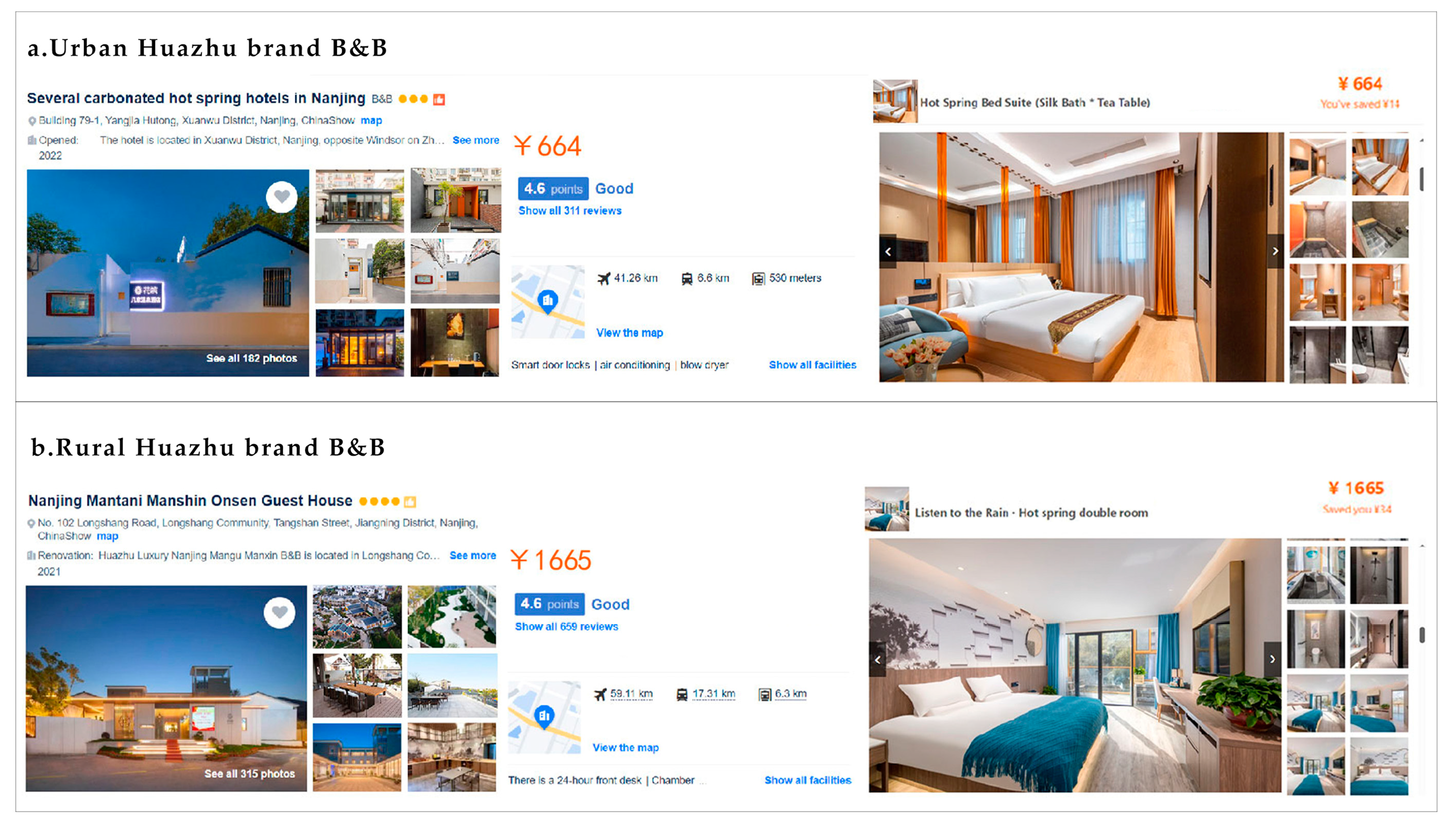
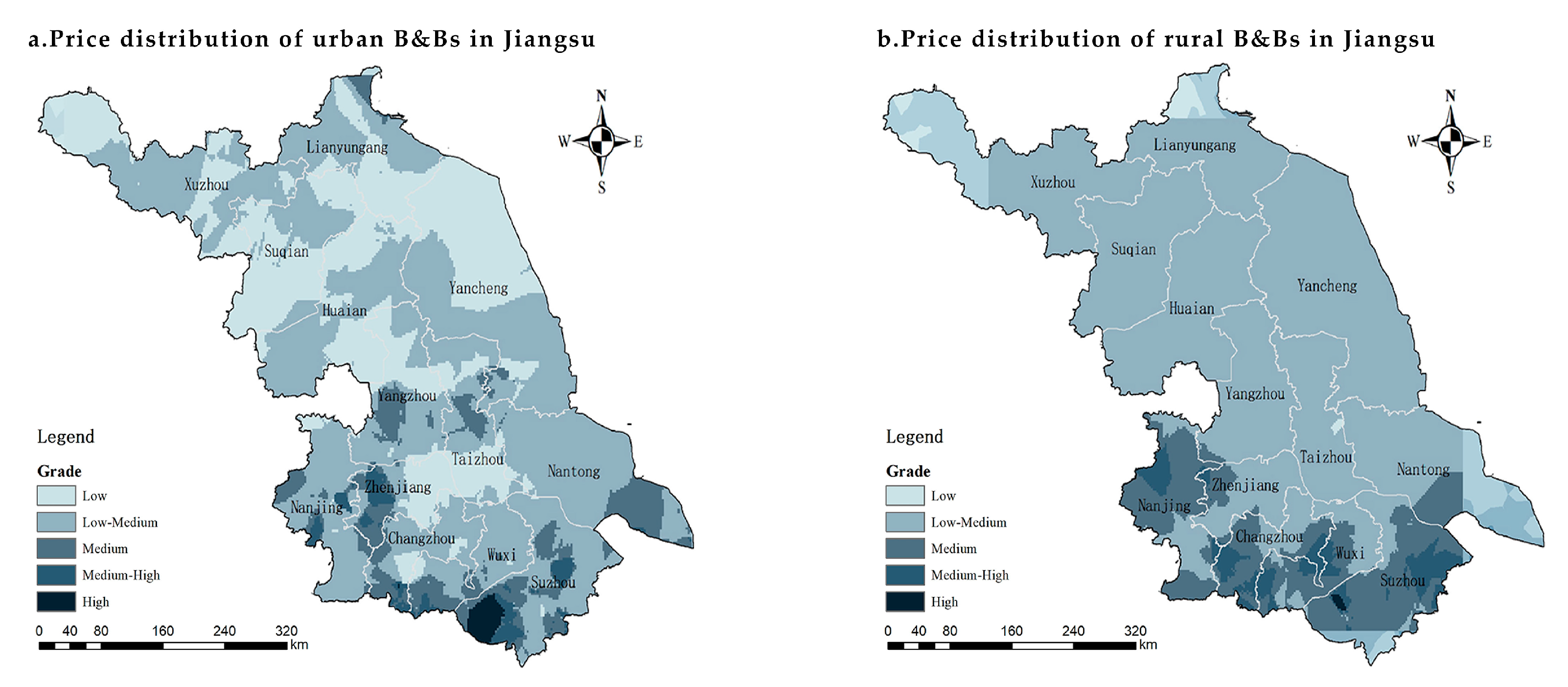
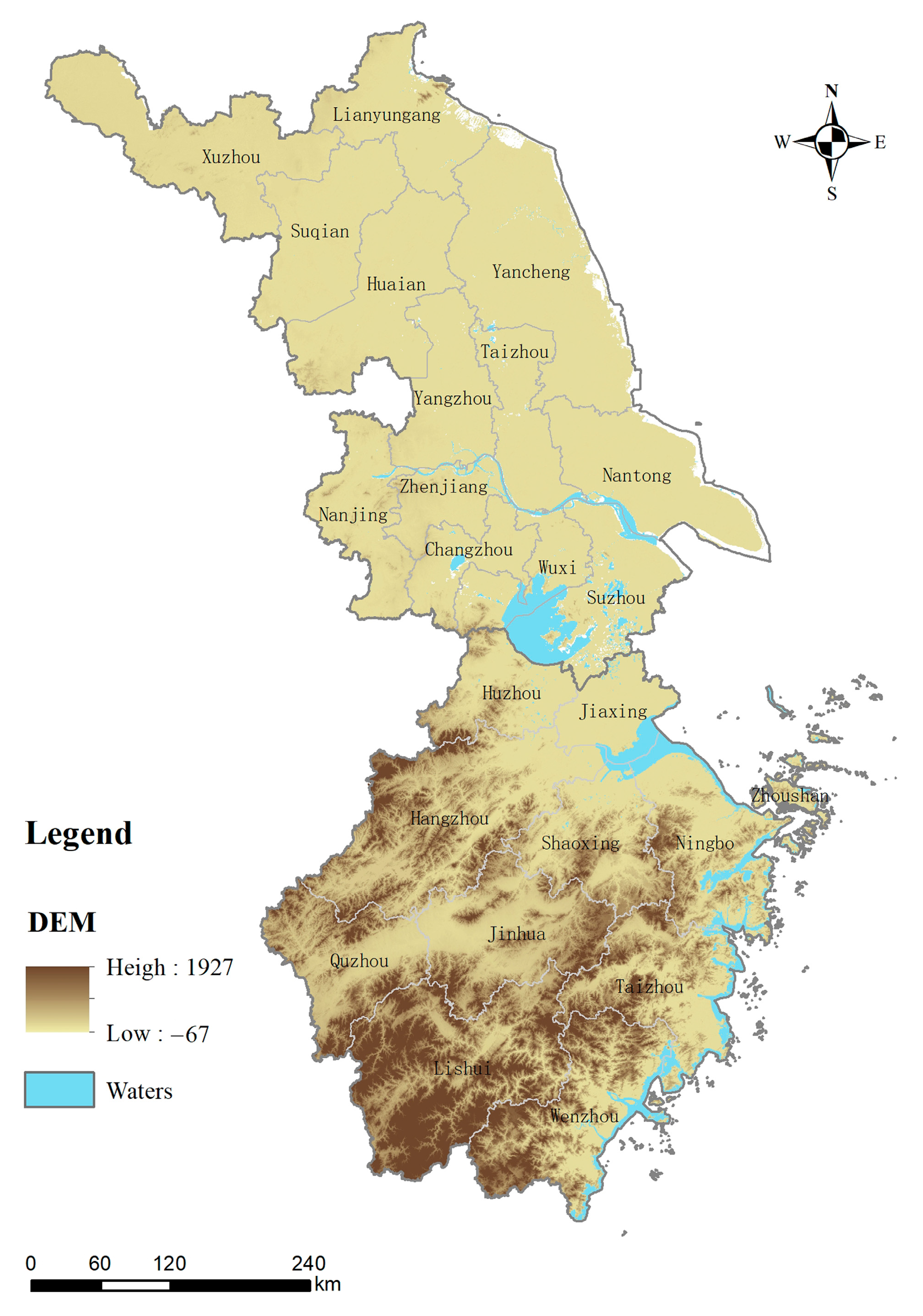
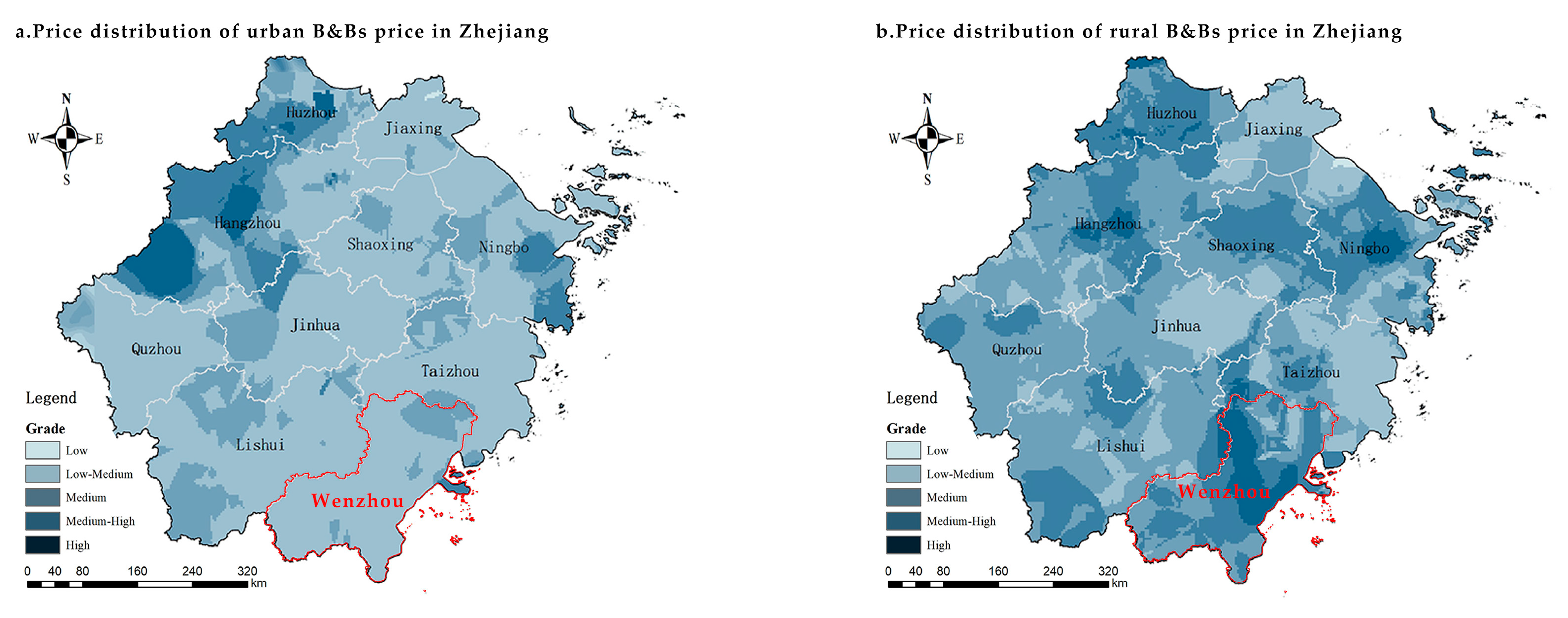
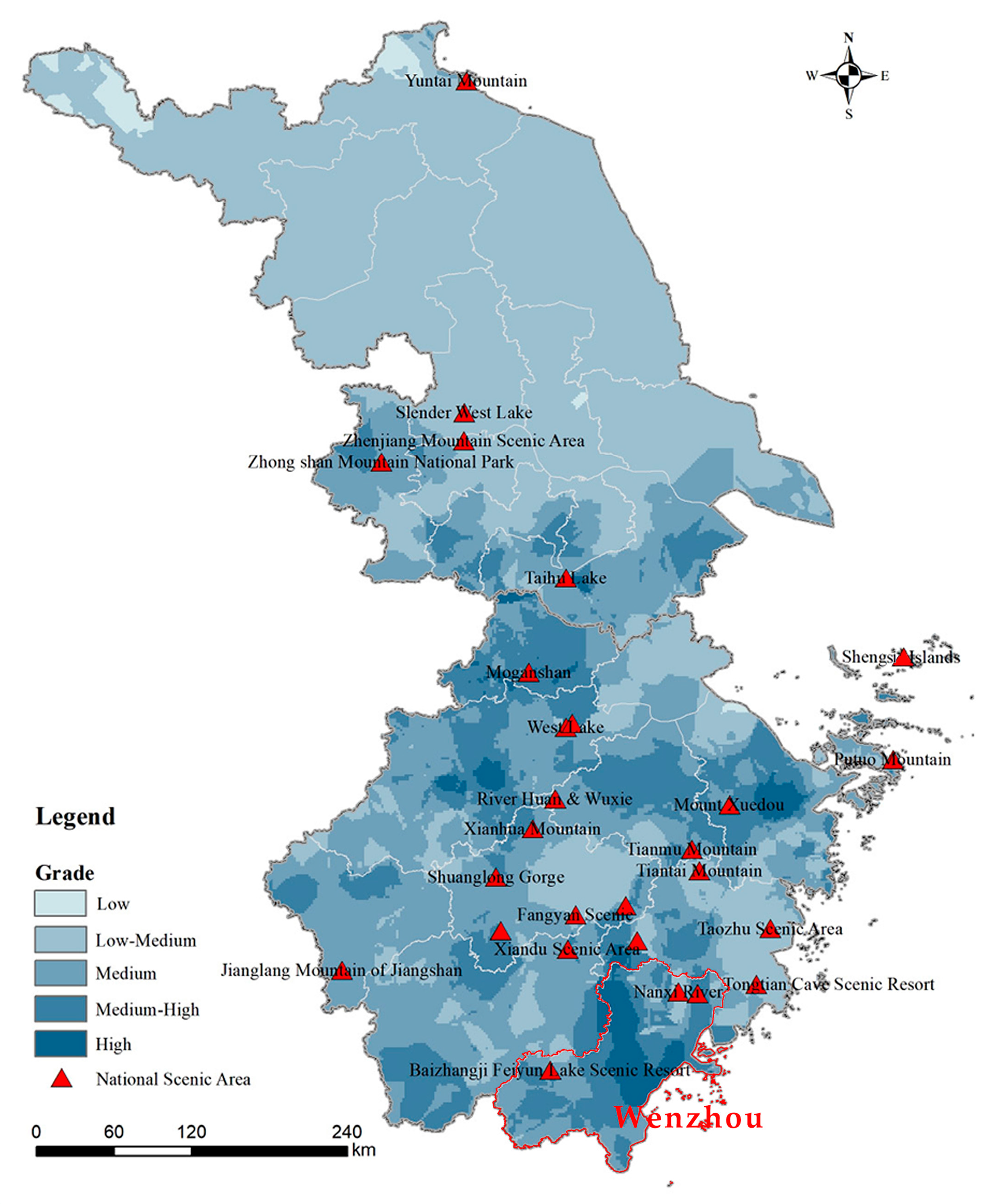
Disclaimer/Publisher’s Note: The statements, opinions and data contained in all publications are solely those of the individual author(s) and contributor(s) and not of MDPI and/or the editor(s). MDPI and/or the editor(s) disclaim responsibility for any injury to people or property resulting from any ideas, methods, instructions or products referred to in the content. |
© 2024 by the authors. Licensee MDPI, Basel, Switzerland. This article is an open access article distributed under the terms and conditions of the Creative Commons Attribution (CC BY) license (https://creativecommons.org/licenses/by/4.0/).
Share and Cite
Yin, J.; Zhao, L. The Value Expression and Driving Factors of Rural Spatial Ecological Products: A Case Study of B&Bs in Jiangsu and Zhejiang Provinces, China. Land 2024, 13, 270. https://doi.org/10.3390/land13030270
Yin J, Zhao L. The Value Expression and Driving Factors of Rural Spatial Ecological Products: A Case Study of B&Bs in Jiangsu and Zhejiang Provinces, China. Land. 2024; 13(3):270. https://doi.org/10.3390/land13030270
Chicago/Turabian StyleYin, Jie, and Lili Zhao. 2024. "The Value Expression and Driving Factors of Rural Spatial Ecological Products: A Case Study of B&Bs in Jiangsu and Zhejiang Provinces, China" Land 13, no. 3: 270. https://doi.org/10.3390/land13030270
APA StyleYin, J., & Zhao, L. (2024). The Value Expression and Driving Factors of Rural Spatial Ecological Products: A Case Study of B&Bs in Jiangsu and Zhejiang Provinces, China. Land, 13(3), 270. https://doi.org/10.3390/land13030270




